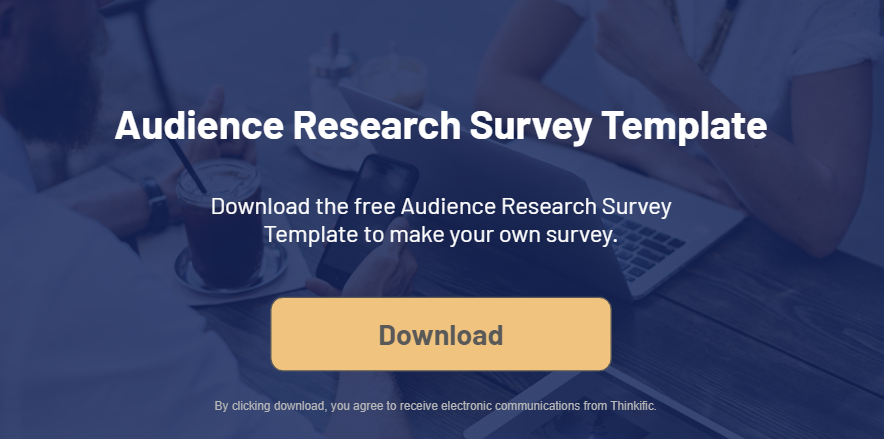‘Organic lead generation’ is one of those marketing terms that sounds confusing — and maybe even a little scary — if you’re not sure what it means.
What does being ‘organic’ have to do with marketing? And for that matter, what is a lead?
But the good news is that beneath the jargon, organic lead generation is all about people.
Organic lead generation means meeting people who might be interested in your business and staying in touch to “nurture” them so that they become customers in the future. Organic lead generation is for everyone, wherever you are in your business journey.
Today, we’re going to explain exactly what lead generation is, how it works, and why you should give it a try.
What is organic lead generation?
Leads are potential customers for your business.
Generating leads means finding these people and collecting their contact information.
Organic lead generation means you’ve connected with those leads, well, organically — without the use of paid advertising!
So despite all the jargon, organic lead generation is actually a very human process.
The idea is to find people who might be interested in your business and build relationships with them. That way, you’ll be top of mind when they’re ready to buy and become customers.
Organic vs. inorganic lead generation
Organic lead generation doesn’t mean customers come to you magically, out of thin air. Instead of paying for their attention through ads, you’ll invest time and energy into attracting them.
A common inorganic lead generation method would be paid search or paid social media ad campaigns. You’ll pay to boost your content and have it shown to more people in hopes of attracting them to your business and collecting their contact information.
Organic lead generation uses those same channels — search, social media, and also content marketing. But instead of paying to get your brand in front of viewers, organic lead generation is about helping new customers discover you naturally, based on a genuine interest in your content.
Why organic lead generation?
The most obvious benefit of organic lead generation is that it’s cost-effective. But the benefits go beyond that, too — paid lead generation is more likely to create a burst of immediate results, whereas organic lead generation is all about patience and consistency.
It’s a steady, ongoing strategy to help you find loyal customers organically. It might take more time and effort to get leads initially, but because they found your content all on their own, they’re genuinely interested — and hopefully, more likely to stick around and eventually buy.
Lower CAC
Since you’re not paying for advertising directly, every customer you gain organically has a lower customer acquisition cost (CAC). For business owners today, that’s more important than ever, since they’re fighting other rising costs due to inflation, supply chain disruption, and other economic factors.
Brand awareness
But organic lead generation should be part of every business’s strategy, and not just because of CAC.
Organic lead gen works especially well for brand awareness and the early stages of the customer journey. Early-stage businesses might choose to forego paid strategies entirely, and instead choose to organically build a community around their brand.
Diversify customer acquisition
Organic lead generation is also highly effective when combined with other ways to connect with new customers.
Using both paid and organic lead generation helps businesses diversify how they acquire customers. That’s important in a digital landscape like ours that’s changing incredibly quickly.
You never know when a customer acquisition technique you relied on might suddenly fall out of favor — just look at how Apple’s privacy updates to its IOS operating system affected targeted advertising!
Related: Top Lead Generation Strategies (And How to Use Them)
How does organic lead generation work?
The basic idea behind organic lead generation is simple.
You’ll publish valuable content your audience is looking for, on the channels where they hang out. Then, you offer them even more value — in exchange for their contact information.
The idea is to publish fantastic content that your audience will find genuinely helpful, entertaining, or educational. There are so many types of content you can use to convert leads, from blog posts to webinars to podcasts.
Some of this content, like SEO-optimized blog posts or social media content, is free and is designed to help your audience discover you.
Then, you offer them even more content, in exchange for contact information like their email address or phone number. This is called a lead magnet, and it’s how you generate organic inbound leads.
The key to success? Enjoyable, helpful, high-quality content.
Here’s some examples of lead magnets:
- How To Guides
- Toolkits
- Reports
- Online Courses
- Webinars
To help you get leads, your content must be accessible, offer value, and solve problems. That’s the only reason your audience will share their contact information — because they’re getting something in return.
💡 Create and publish a lead magnet funnel in minutes with Thinkific Funnels
Leveraging our AI powered funnel, build and publish a landing page to offer a free digital download to your prospects in return for their email addresses.
Basic steps of organic lead generation
Organic lead generation can be summed up in this simple 3-step process, also known as a lead magnet funnel.
1. Attract traffic to your site
- Publish content that appeals to your target audience and solves their problems
- Use organic social media content to drive traffic back to your website
- Optimize your website content with keywords your target audience is searching for
Related: How to Increase Website Traffic (41 Ways)
2. Convert traffic to leads
- Offer your website visitors something of value — such as a lead magnet — in exchange for their contact information
- Design a special landing page on your website around this offer
- Optimize your website for an easy, intuitive user experience
3. Nurture leads into customers
- Stay in touch with your leads, and build strong relationships by providing even more value and showcasing your expertise
- Email, social media, and SMS are all great ways to do this
- Keep consistently providing high-quality content
Related: 6 Step Lead Magnet Funnel To Capture & Convert Prospects (+Templates)
Ingredients for great organic lead generation
This might sound like a simple process. But organic lead generation is surprisingly hard to execute well.
The right approach will be different for every brand, but it all comes back to:
- Knowing your audience
- Publishing high-quality content
- Using technical tips and tricks to help them find it
- Nurturing your leads after you’ve acquired them
Here’s our starter guide to designing an organic lead generation strategy that works.
Know your audience
Effective organic lead generation always starts with audience research.
The whole point is to help your potential customers, and build strong relationships with them. How can you do that if you don’t even know who they are?
Start with audience research
Try collecting data on your customers with a survey, or if you’re a new company, researching the typical demographics of customers in your niche. You can also think through your ideal customers, and what problems you’d help them solve.
Investigate questions like:
- What pain points are your prospective customers facing? What problems are they trying to solve?
- What channels, like your blog, email or social media, will be the best way to reach them? What kinds of content do they most enjoy?
- What’s their typical age, gender, income and type of profession? What do they like to do in their free time?
Use your findings to craft 1-3 user personas. Keep these customers in mind as you craft your content and strategy — this will make all your content feel much more consistent, authentic, and personal.
Tailor your approach to your audience
Audience research makes designing your lead generation strategy so much easier.
You don’t have to wonder what kind of content to create, lead magnets to offer, or platforms to focus on. Instead, refer to the buyer personas you created during audience research!
There are so many types of content marketing to experiment with, from blog posts to infographics, and millions of possible lead magnets, like cheatsheets, ebooks, and templates.
Getting traffic to your website
There are two main mechanisms for getting potential leads to your website — organic search engine optimization (SEO), and content marketing.
Organic search (SEO)
To make sure your website comes up in your audience’s search results, you’ll need to do some keyword research.
SEO and keyword research is a huge topic, and it can be intimidating for beginners. If you’re not sure where to start, we interviewed expert Stephan Spencer. Get his SEO tips for course creators and a full tutorial here!
Long-tail keywords
We recommend focusing on narrower, more specific long-tail keywords — think “local honey producers Philadelphia,” instead of “natural honey.”
While fewer people are searching for these keywords, those who are are much more likely to be in your target audience and are more likely to purchase your products and services in the future. Plus, these smaller niche keywords are much less competitive, meaning your content has a higher chance of being seen!
Google ‘My Business’ Listing
If you want customers to contact you after searching, your Google My Business listing is extremely important.
This card is displayed at the top of searchers’ results and displays your business name, a short description, and your contact details. If any of that information is out of date, you’re losing potential business — so make sure your leads have an easy way to contact you!
Content marketing
Great content caters to your customers’ needs, interests, and problems.
Whether you’re solving a common challenge they face, or delighting them with beautiful illustrations and design, your content should improve their lives in some way. That’s how you offer value and start building meaningful customer relationships.
Search engine-optimized website content
Most people think about blog posts when they think about SEO content.
And great blog content is a classic for a reason! It’s a powerful way to share valuable information, and it’s easily optimized so that your target audience can find you.
But it’s far from the only kind of content worth your while. Try out video content, podcasts, infographics and more, depending on what your audience prefers. We have plenty of content ideas here to help you get started.
Organic social media lead generation
Reaching new leads on social media, especially Facebook and Instagram, isn’t as easy as it used to be.
But if these are your target audience’s preferred platforms, it’s still the best way to reach them — and some platforms still have plenty of potential when it comes to lead generation.
You’ll want to create content that drives back to your website or landing page, where you’ll offer visitors your lead magnet and ask for their contact information.
It’s also a great place to stay in touch with existing customers and work on building your brand community!
Related: 15+ Customizable ChatGPT Prompts for Social Media
Optimizing your site for conversion
Whether you’re directing traffic to your homepage, your blog, or a special landing page, you need to give visitors a seamless, intuitive user experience.
Fast, responsive, high-quality website
To convert visitors into leads, your website must provide a quality experience for users.
Here’s a quick checklist for a lead-generation-friendly site:
- Fast load time: Loads within 2-3 seconds
- Mobile friendly: Gives a quality experience on different devices
- Clean, on-brand design
- Simple and easy to navigate, with the most important information highlighted
Customized landing pages
To connect with potential customers even more strongly, try directing them to a customized landing page.
A common method is to build a landing page around your lead magnet, explaining its value and asking for contact information. You can also build a landing page for each buyer persona, or build a new one, along with a new lead magnet, for each new lead generation campaign.
You can direct people to your landing page through social media posts, a pop-up on your home page or blog, and content they found through a search engine.
Need help building a landing page for your lead magnet? Explore Thinkific’s Free Download Funnel to quickly build and publish your own landing page and offer a free digital download to your prospects in return for their email addresses.
Convert traffic to leads by offering value
Finally, it’s time for your offer! What will you offer your leads to invite them into your community?
Most often, you’ll be collecting customers’ email addresses, so that you can add them to your subscriber list. But you might also offer a lead magnet in exchange for phone numbers, so that you can send marketing messages, too.
The options are nearly endless. But here are a few ideas to get you started:
Downloadable lead magnets
One very popular style of lead magnet is a downloadable product that is sent to the customer’s email after they share it with you.
The best lead magnets respond to what your customers need, value and care about.
Are you offering a course to help small businesses with their bookkeeping? Try a template accounting spreadsheet.
If your customers love beautiful art and decor, offer them an original desktop or smartphone wallpaper.
If your brand is all about education and self-improvement, try offering customers a printable challenge, workbook, or course.
Other types of lead magnets
Not every lead magnet is a downloadable PDF.
One particularly clever idea is to make you email list itself the lead magnet, by promising customers tons of valuable, exclusive content they won’t find anywhere else.
Gating part of your website as a free members-only community is a similar idea, as is reserving certain articles, videos, or other pieces of content for members only.
You can also try offering invites to virtual events — or even real-world ones — in exchange for email signups.
Find your leads
Organic lead generation isn’t just marketing-speak.
It’s about helping your business or product connect with the people who need it.
Even if you’re just getting started, there are thousands of people out there who would love to discover your product, and who care about what you have to say.
By paying attention to what they need, want, and care about, you can solve their problems, make their lives better, and build a network of strong relationships around your brand.
Looking to start generating consistent quality leads for your business?
Thinkific Plus makes it easier to transform leads into brand advocates by offering high-value education at every stage of the customer journey. It’s so simple to use, that you can focus on generating demand—not worrying about technology.
Learn more about Thinkific Plus or book a call with our team to try it today.
This post was originally published in January of 2023 and updated in September 2023 with additional value.










